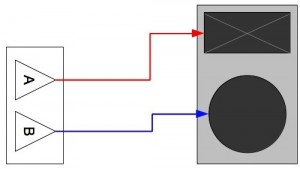by Ben Stowe, CTS - “Sound & Lighting Guru”
 Bi-Amping a loudspeaker or a system in it’s simplest form is just what the name states, using two amps for the job.
Bi-Amping a loudspeaker or a system in it’s simplest form is just what the name states, using two amps for the job.
Typically this is used to independently control the levels and frequencies going to a particular driver within a loudspeaker.
In Illustration 1 we can see this accomplished with amplifiers A and B. We’ve shown the high frequency path in red and low frequency in blue. Sometimes, however, it is used to describe the process of powering a “top” box that has a passive crossover network inside of it separately from a subwoofer.
In this case amplifier one provides a broad signal range (typically 100 Hz to 16 kHz) to the top box where it’s internal crossover decides what of that signal goes to each component within it, and the other amplifier provides a narrow signal (typically 30 Hz to 100 Hz) to the subwoofer.
This is shown in Illustration 2.
The decision of what frequencies should go to which device is based on the crossover point of each device.
With self-powered loudspeakers manufacturers often employ two amplifiers within a “full range” or “top” box so the bi-amping occurs behind the scenes (Illustration 3).
You simply provide a full range signal to the box and it processes it. Further, if you decide to add a subwoofer to the system many manufacturers make this easy for you as well.
Sometimes the subwoofers have a “high pass” output that provides a signal compatible with that subwoofer’s crossover point for the top box. Other times the top box has a switch on it that simply says “with sub” and “full range”. When the switch is set to “with sub” the box automatically rolls off the lower frequencies (typically around 100 Hz).
If we connect a signal to a self-powered subwoofer and a self-powered bi-amped full range box, we technically have a tri-amped system because we are using 3 amplifiers, each producing a processed set of frequencies specific to the driver it is connected to.
If your loudspeakers are not self-powered, or they do not have internal crossover point settings, we will use a crossover to direct the traffic between the amplifiers.
Whether the amplifier is in your rack or mounted inside your loudspeaker is of little consequence, it’s still an amp that powers a speaker. What we need to determine now is where the crossover point should be set. This information should come from the loudspeaker manufacturer. It is often published in the specifications or data sheet.
In Illustration 4 we see an active crossover being used to split the signal between a self-powered top and a self-powered subwoofer. More often than not you can use a DSP (Digital Signal Processor) which will not only provide you with a crossover, but inside a single devices will also offer equalization, compression, limiting, delay and several other audio processing capabilities.




